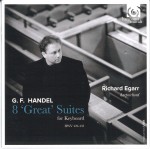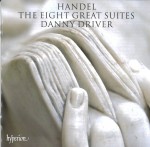
 Handel – 8 “Great” Suites
Handel – 8 “Great” Suites
Richard Egarr
Harmonia Mundi HMU 907581.82
Handel – The Eight Great Suites
Danny Driver
Hyperion CDA68041/2
Harpsichord or piano for Handel? Two CD collections have simultaneously been released, continuing to ask the question. Pianist Danny Driver opens the account for Hyperion, his prelude (described in the sleeve notes as “ruminative”) being a thoughtful, cautious approach before the allemande, courante and gigue, not so far removed from their rural roots. Harpsichordist Richard Egarr is more cautious in his courante before an excited gigue. At this early point, it is difficult to judge which instrument is the more suited.
Suite 2 starts with a restful adagio followed by a highly spirited allegro, demanding for both pianist and harpsichordist. Driver’s interpretation would have communicated to an 18th-century harpsichord audience exactly what the piano still demands of its players three centuries on. The second adagio and allegro: fugue are a relaxing contrast. Egarr tackles with enthusiasm the first allegro which must be a highlight of the baroque repertoire.
And so to the contemplative Suite 3 and its air with five gentle variations. This is the chance to take a breath and compare instruments. While much of early music was not scored for any particular instrument, one does wonder why a piano is selected; the harpsichord is not deficient in any way as Egarr’s glorious presto testifies. It may be the case that harpsichords were not available in previous decades: the piano was ready to stand in and this practice has never ceased.
Suite 4 begins with another allegro: fugue which is almost a cliché of baroque keyboard playing. Its “hammer blows” are, in fact, more vigorously interpreted by Driver’s piano playing – Egarr’s harpsichord is played with passion but it is still overshadowed, a process repeated with the allemandes. There is a tenderness to both sarabandes and it is difficult to say which is the more sensitive.
Driver’s piano-playing gives a thoughtfulness to the Suite 5 prelude and allemande before its spirited courante. Egarr’s prelude and allemande are slower; perhaps that word ruminative applies to him this time round. And so to the air with five variations, the universally loved “Harmonious Blacksmith.” Driver is sensitive in his interpretation, Egarr more virtuosic and more effervescent in his playing.
“The Harmonious Blacksmith” is a hard act to follow. Both Driver’s and Egarr’s renditions of the Suite 6 gigue are dashing, in contrast with the largo in the same suite. It is easy to say that the remaining suites comprise the dance-based movements already discussed, but Suite 7 concludes with a passacaille: chaconne. With Egarr’s combination of strident and exuberant playing, perhaps this movement is the sole differentiation between piano and harpsichord.
And on a personal note, Driver’s sleeve notes refer to frescoed ceilings by Bellucci. They are still there in the local Church of St. Lawrence: this reviewer grew up a half mile from them.



